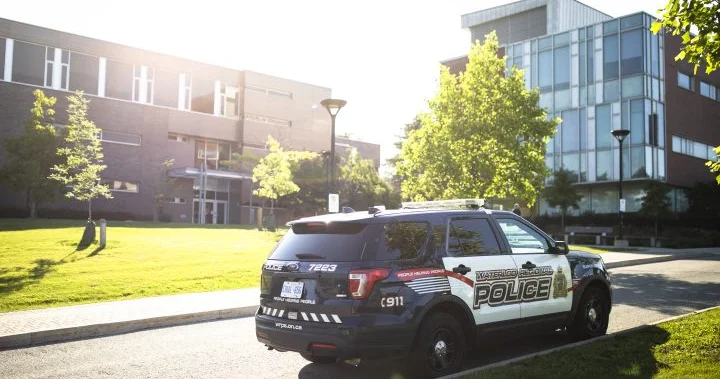
Students standing in solidarity with Waterloo school stabbing victims – Jun 30, 2023
The recent University of Waterloo stabbing that sent shockwaves across the country has prompted other Canadian universities to review their own security measures.
Two students and a professor were injured after a man showed up in class June 28 and drew knives after confirming it was a second-year gender studies class; police have described it as a “hate-motivated” attack.
Geovanny Villalba-Aleman, a 24-year-old recently graduated international student, faces three counts of aggravated assault, four counts of assault with a weapon and two counts of possession of a weapon for a dangerous purpose, as well as mischief under $5,000. He appeared in a Kitchener, Ont., court Tuesday morning, but his case has been postponed to July 25.
The violence has raised concern about an increase in crime on campus as post-secondary institutions across the country look for ways to keep students, faculty and staff safe.
“Following the University of Waterloo incident, UBC Safety and Risk Services reviewed our protocols to determine if there are any opportunities to improve our safety processes,” said Sam Stephens, director of campus security at the University of British Columbia Vancouver.
“We continually review our security protocols to ensure we are following best practices to support a safe environment on campus,” Stephens said in an emailed statement to Global News.
UBC’s annual campus security reports released last month showed an uptick in assaults at both the Vancouver and Okanagan campuses last year.
The University of Alberta has also seen an increase in overall security incidents on campus in recent months, with at least 444 crimes reported to date this year, according to a U of A spokesperson.
“While the current increases may not seem significant to some, we recognize that any incident can be worrisome to those that regularly use the space,” said Ross Neitz, U of A’s media relations strategist.
Last year, there were 686 criminal incidents at the U of A campus, that included property crimes and crimes against persons, according to Neitz.
“We are currently exploring many avenues related to safety and security from those concerns being raised following this assault,” Verna Yiu, U of A’s interim provost said in June 30 statement released in response to the Waterloo stabbings.
“Some of these include looking into how instructor information is publicly posted, collaborating with those who teach and research in these areas to identify actions, and advancing conversations around restorative practices,” the statement read.
At the University of Toronto’s three locations, a total of 670 security incidents were reported and responded to last year, which ranged from breaking and entering and theft to sexual assault, criminal harassment and hate crime, according to data for their annual campus safety reports.
That was a 38 percent jump compared to 2021 for the same types of incidents reported on all three campuses involving either the general public or members of the U of T community. The university was mostly offering online classes due to COVID-19 up until the fall semester that year, which meant there were fewer students on campus.
“We are deeply troubled by the vicious attack that took place … at the University of Waterloo, and we denounce hate and violence in all forms,” a U of T spokesperson said in an emailed statement to Global News last week.
“We regularly review our emergency response and communications systems to keep our campuses as safe as possible, and we routinely assess new or emerging concerns, working with community partners such as local police services, where appropriate,” the statement added.
In the aftermath of the Waterloo attack, the University of Saskatchewan (USask) said it is committed to providing a safe and welcoming learning environment for all students, staff and faculty.
From Jan. 1, 2022, to July 2023, USask protective services responded to 20 calls reporting assaults, 24 reports of breaking and entering, 45 reports of harassment, 100 reports of theft and conducted 19 arrests under warrant.
USask said it has one of the few dedicated peace officer groups in Western Canada that enhances the university’s ability to detect and address incidents on campus most often without police involvement.
“This can lead to a higher number of incidents reported relative to other universities, as we are able to respond to incidents within 500 meters of our campus in a timely manner,” a statement from USask emailed to Global News said.
Montreal’s McGill University said the safety and well-being of every member of its community always remain a top priority.
“We stand with members of our community who may be concerned that their teaching, research, or advocacy might heighten their vulnerability to such incidents,” said Claire Loewen, a McGill University spokesperson.
“Violence and discrimination of any form have no place in our society.”
Ensuring the safety of Canadian universities in the wake of the Waterloo attack requires a proactive and comprehensive approach. Here are some key steps that universities can take to ramp up their security measures:
Conduct Security Audits: Begin by conducting thorough security audits of the campus facilities, identifying potential vulnerabilities, and assessing the effectiveness of existing security measures. This evaluation will provide a baseline for improvements.
Enhance Surveillance Systems: Upgrade surveillance systems by implementing advanced technologies such as high-resolution cameras, facial recognition software, and intelligent analytics. These enhancements will improve monitoring capabilities and aid in the early detection of suspicious activities.
Strengthen Access Control: Implement robust access control measures throughout the campus. This may include the use of key card systems, biometric scanners, or security personnel stationed at entry points to verify identification. Limiting unauthorized access is critical in preventing potential threats.
Develop Emergency Response Plans: Review and update emergency response plans, ensuring they are comprehensive and include procedures for various scenarios. Conduct regular drills and training sessions to familiarize staff and students with the protocols and enhance their ability to respond effectively in emergencies.
Collaborate with Law Enforcement: Establish strong partnerships with local law enforcement agencies to facilitate information sharing and coordination during critical incidents. Regular meetings, joint training exercises, and sharing best practices will enhance the overall security posture of the university.
Promote Security Awareness: Launch campus-wide security awareness campaigns to educate students, faculty, and staff about potential threats and the importance of reporting suspicious activities. Encourage a culture of vigilance and provide channels for anonymous reporting.
Invest in Staff Training: Provide comprehensive training to campus security personnel, equipping them with the skills and knowledge necessary to handle security threats effectively. This may include conflict resolution, de-escalation techniques, and emergency response training.
Leverage Technology: Explore the use of technological innovations such as mass notification systems, mobile safety apps, and digital panic buttons to enhance communication and response capabilities during emergencies. These tools can improve the speed and efficiency of emergency alerts and notifications.
Engage the Campus Community: Foster a sense of community and collaboration by involving students, faculty, and staff in the security planning process. Encourage open dialogue, feedback, and the reporting of any potential security concerns.
Continuously Evaluate and Improve: Regularly assess the effectiveness of the implemented security measures through ongoing evaluations, feedback mechanisms, and data analysis. Stay up-to-date with emerging security trends and technologies to adapt and enhance the university’s security strategy accordingly.
By following these steps, Canadian universities can take a stand against threats and create a safer environment for their campus communities. The commitment to continuously review and improve security measures is essential to staying ahead of potential risks and ensuring the well-being of all stakeholders.


